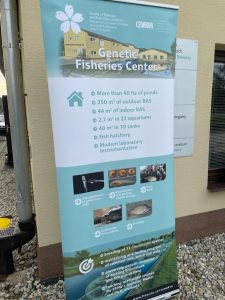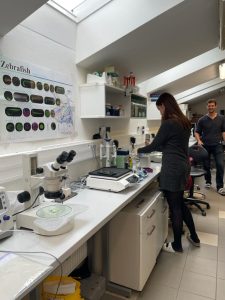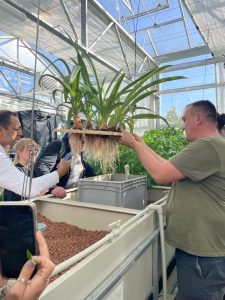The end of seminar on topic «Inland Fisheries Management and Aquatic Biodiversity Conservation»
The end of seminar on topic «Inland Fisheries Management and Aquatic Biodiversity Conservation»
In a frame of seminar in the n university of CENAKVA «South Bohemian Research Centre of Aquaculture and Biodiversity of Hydrocenoses» (Vodňany, Czech Republic) several excursions on experimental fish reproduction bases and scientific laboratories of the Faculty of Fisheries and Protection of Waters were conducted. During the excursions, to the participants of the seminar were highlighted the main technological aspects of fish reproduction and modern scientific research projects of intensification of fish reproduction of hydrobionts and the next information about fish reproduction systems and experimental laboratories of CENAKVA Faculty of Fisheries and Protection of Waters:
- System of aquaponics. System of aquaponics includes various amount of technological subsystems: 1) aeroponics; 2) nutrient film technique; 3) drip sustem; 4) deep water farming. The main objects of cultivation in aquaponics are tilapia and wels catfish. The harvest from green plants is 750 kg per year. For cultivation, greens (lettuce leaves and cilantro), cucumbers, tomatoes and peppers are used. The sale of commercial fish occurs when the commodity weight reaches 300-400 grams in local restaurants and cafes.
- Center of fish genetics. Experimental ponds and pools for the cultivation of valuable fish species represent the center. The center grows 10 species of sturgeon fish species, among which there are rare and endangered species of fish, such as bastard sturgeon (Acipenser nudiventris). The center is also engaged in the germination of wels catfish and carp. The current direction of the laboratory is the transplantation of stem cells of valuable commercial fish species into short-cycle fish species in order to obtain offspring in a short period.
- Laboratory of Cryopreservation and Biochemistry. The first direction of the laboratory is the cryopreservation of sperm of commercially demanded fish species, the preservation of reproductive cells of rare fish species and the development of aquaculture by preserving valuable fish species (lines) and installing cryobanks at large fish farms. The second direction is the assessment of pollution of aquatic ecosystems and the conduct of toxicological studies in the event of a mass death of fish.
- Intensive Aquaculture Laboratory. The laboratory is engaged in the cultivation of fish using a combined technology (RAS — recycling aquaculture system + ponds). The total number of ponds is 50 pcs., each of 0.25 hectares. The main objects of cultivation are sander, carp and koi carp, there is also an experimental base for the cultivation of crayfish. The fish is sold after reaching a commodity weight of 20-30 grams. On average, 800,000 units of sander are sold per year.
At the end of the seminar, all participants were awarded personal certificates.






